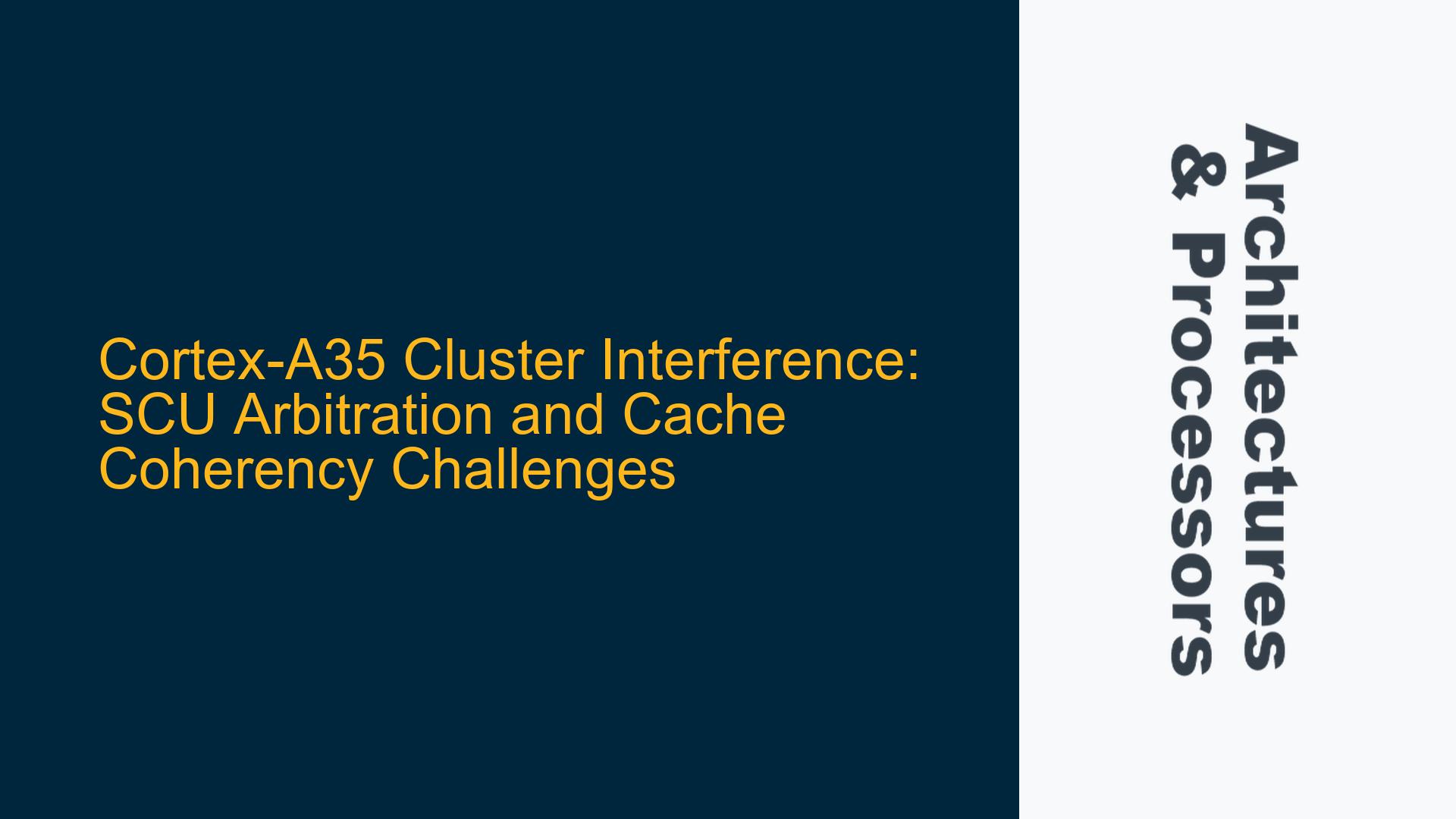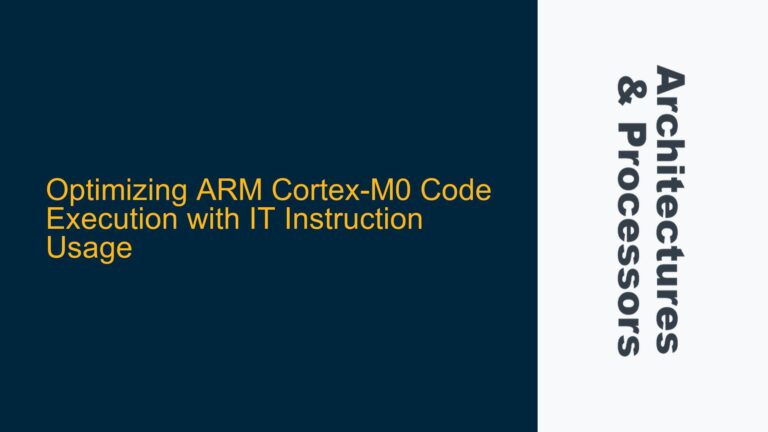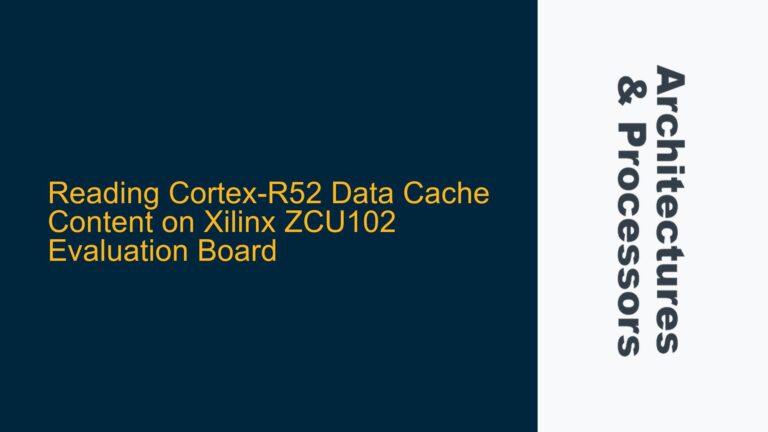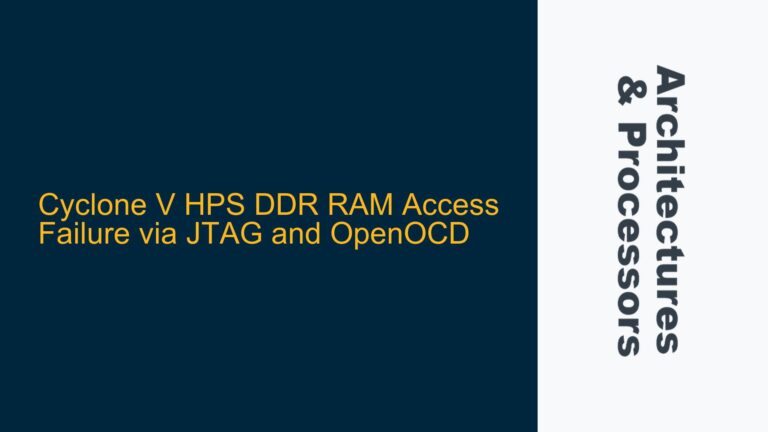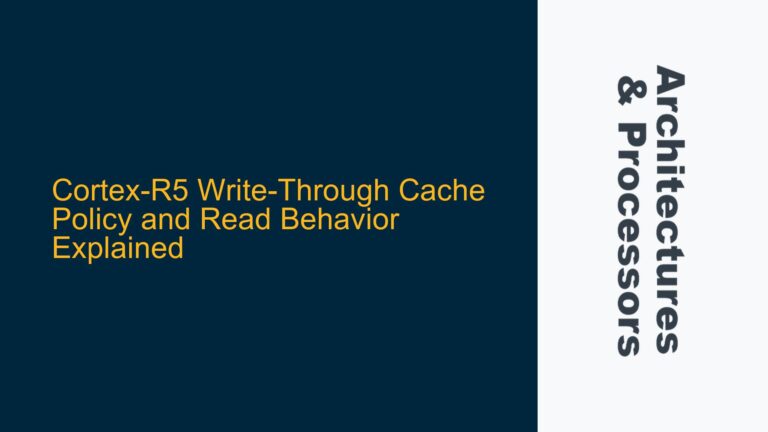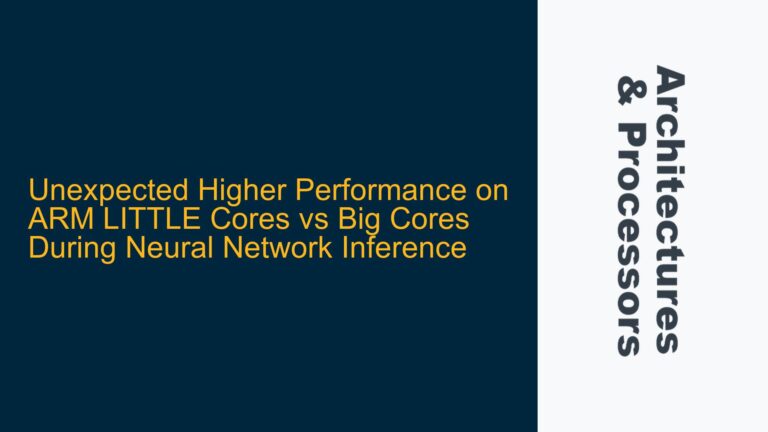Cortex-A35 SCU Arbitration and Core Interference in Multi-Core Clusters
The Cortex-A35 processor, known for its power efficiency and scalability, is often deployed in multi-core configurations, such as the quad-core cluster found in the NXP i.MX8QX. One of the critical challenges in such configurations is understanding and managing the interference between cores, particularly when accessing shared resources like the L1/L2 caches and the AXI4/ACE/CHI memory bus. The Snoop Control Unit (SCU) plays a pivotal role in managing cache coherency and arbitration among the cores, but its behavior and performance implications are not always well-documented. This post delves into the intricacies of SCU arbitration, the potential causes of core interference, and actionable steps to diagnose and mitigate these issues.
SCU Arbitration Mechanisms and Core Interference in Cortex-A35 Clusters
The Snoop Control Unit (SCU) in the Cortex-A35 cluster is responsible for maintaining cache coherency and arbitrating access to shared resources. The SCU ensures that all cores in the cluster have a consistent view of memory by managing snoop requests and coordinating cache line transfers. However, the arbitration mechanisms employed by the SCU are not explicitly detailed in the Cortex-A35 Technical Reference Manual (TRM), leading to ambiguity in understanding its behavior.
The SCU operates at the cluster level, interfacing with the L1 caches of each core, the shared L2 cache, and the AXI4/ACE/CHI memory bus. When multiple cores attempt to access the same memory region or cache line, the SCU must arbitrate these requests to prevent data corruption and ensure coherency. The arbitration policy determines the order in which requests are serviced, which can significantly impact performance, especially in high-contention scenarios.
One of the key challenges is determining the theoretical maximum interference between cores. This interference arises when multiple cores contend for the same resources, such as the L2 cache or the AXI bus. The SCU’s arbitration policy, combined with the memory access patterns of the cores, dictates the extent of this interference. For example, if one core is performing a burst of non-cacheable memory accesses while another core is fetching data from the L2 cache, the SCU must prioritize these requests to avoid bottlenecks.
Additionally, the SCU’s behavior when accessing non-cacheable regions (e.g., device memory) is another area of concern. Non-cacheable accesses bypass the L1 and L2 caches, but they still require arbitration by the SCU to ensure that they do not conflict with cacheable accesses. Understanding how the SCU handles these mixed access patterns is crucial for optimizing performance in heterogeneous workloads.
Memory Access Patterns, Cache Coherency, and SCU Arbitration Policies
The interference between Cortex-A35 cores in a cluster is influenced by several factors, including memory access patterns, cache coherency requirements, and the SCU’s arbitration policies. These factors can lead to performance bottlenecks if not properly understood and managed.
Memory Access Patterns
The memory access patterns of the cores play a significant role in determining the level of interference. For example, if all four cores in a cluster are accessing the same cache line simultaneously, the SCU must handle multiple snoop requests and cache line transfers, leading to increased latency. Similarly, if one core is performing a large number of non-cacheable accesses (e.g., to device memory), it can monopolize the AXI bus, causing delays for other cores attempting to access cacheable memory.
Cache Coherency Requirements
The Cortex-A35’s cache coherency protocol, managed by the SCU, ensures that all cores have a consistent view of memory. However, maintaining coherency can introduce overhead, especially in high-contention scenarios. For example, when a core modifies a cache line, the SCU must invalidate or update the corresponding cache lines in other cores, which can lead to increased latency and reduced throughput.
SCU Arbitration Policies
The SCU’s arbitration policies determine how requests from different cores are prioritized and serviced. These policies are not explicitly documented in the Cortex-A35 TRM, making it difficult to predict their impact on performance. For example, the SCU may use a round-robin policy to ensure fairness, or it may prioritize certain types of requests (e.g., cacheable over non-cacheable) to optimize throughput. Understanding these policies is essential for diagnosing and mitigating performance bottlenecks.
Vendor-Specific Implementations
While the SCU is part of the Arm Cortex-A35 design, its implementation and performance characteristics can vary depending on the SoC vendor. For example, NXP’s implementation of the Cortex-A35 in the i.MX8QX may include vendor-specific optimizations or modifications to the SCU’s arbitration policies. These vendor-specific details are often not publicly documented, requiring direct engagement with the vendor for clarification.
Diagnosing and Mitigating Cortex-A35 Core Interference: SCU and Cache Management Strategies
To address the challenges of core interference in Cortex-A35 clusters, a systematic approach to diagnosing and mitigating these issues is required. This involves analyzing memory access patterns, optimizing cache usage, and leveraging tools to monitor and profile SCU behavior.
Analyzing Memory Access Patterns
The first step in diagnosing core interference is to analyze the memory access patterns of the application. This can be done using performance monitoring tools that track cache hits, misses, and bus utilization. By identifying hotspots and contention points, developers can optimize their code to reduce interference. For example, aligning data structures to cache line boundaries and minimizing false sharing can significantly improve performance.
Optimizing Cache Usage
Effective cache management is critical for reducing interference in Cortex-A35 clusters. This includes configuring the L1 and L2 caches to match the workload’s requirements and using cache maintenance operations to ensure coherency. For example, the DCIMVAC (Data Cache Invalidate by MVA to PoC) and DCCIMVAC (Data Cache Clean and Invalidate by MVA to PoC) instructions can be used to manage cache lines explicitly.
Leveraging Performance Monitoring Tools
Arm provides a range of performance monitoring tools, such as the Arm Development Studio and the Performance Monitoring Unit (PMU), which can be used to profile SCU behavior and identify bottlenecks. These tools provide detailed insights into cache coherency transactions, bus utilization, and arbitration delays, enabling developers to pinpoint the root cause of interference.
Implementing Data Synchronization Barriers
Data synchronization barriers (e.g., DSB and DMB) can be used to enforce ordering constraints on memory accesses, ensuring that critical operations are completed before proceeding. This is particularly important in multi-core systems, where out-of-order execution can lead to coherency issues.
Engaging with SoC Vendors
Given the potential for vendor-specific variations in SCU implementation, engaging with the SoC vendor (e.g., NXP) is often necessary to obtain detailed documentation and support. This can include access to proprietary tools, example code, and technical guidance on optimizing performance for specific use cases.
Example: Optimizing Non-Cacheable Accesses
Consider a scenario where one core is performing frequent non-cacheable accesses to device memory, while other cores are accessing cacheable data. To minimize interference, the non-cacheable accesses can be batched and aligned to AXI burst boundaries, reducing the number of transactions and freeing up bandwidth for other cores. Additionally, the use of AXI Quality of Service (QoS) features can prioritize critical transactions, ensuring that latency-sensitive operations are not delayed.
By understanding the intricacies of SCU arbitration, cache coherency, and memory access patterns, developers can effectively diagnose and mitigate core interference in Cortex-A35 clusters. This requires a combination of analytical tools, optimization techniques, and vendor engagement to achieve optimal performance in multi-core systems.
